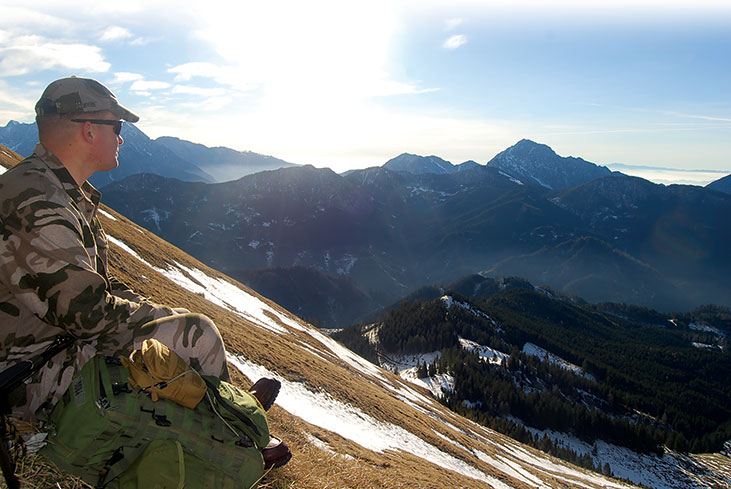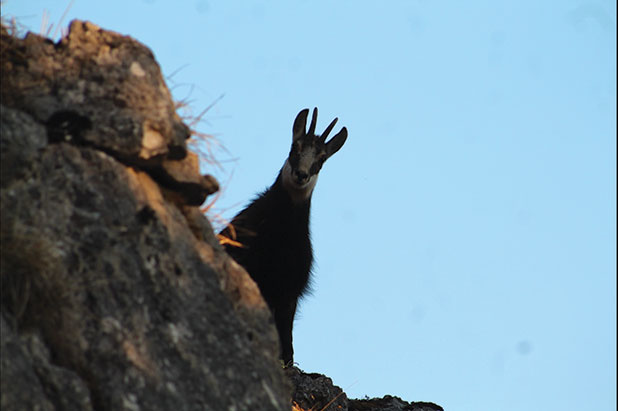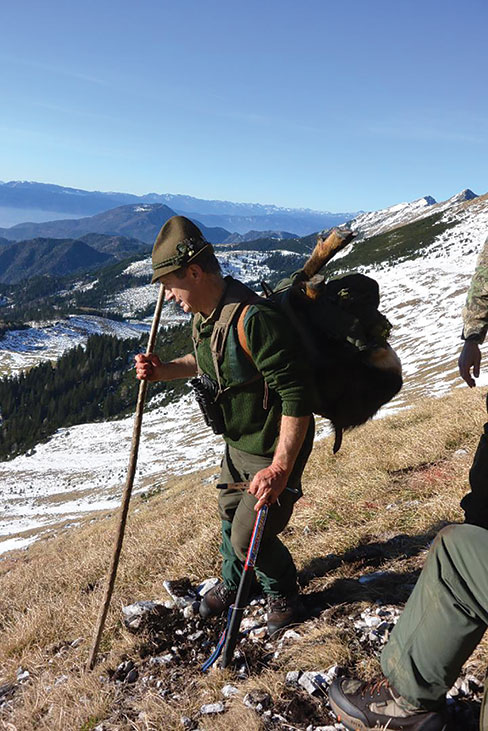Gamsbok in the Julian Alps
In some way, all of my hunts connect to each other and will often find their own culmination. This may not always be achieved when the hunted animal is harvested or meet my personal timeline.
In 1992, I unsuccessfully hunted in Alaska for a Dall ram. Raised in the Deep South at sea level, I’ve always reveled in the idea of hunting in the mountains. In 2015, and in all places, the Slovenian Alps, I was finally able to fulfill a 23-year pursuit of a successful hunt in the mountains.

One of my later assignments as a career Army Officer was served in Germany. I earned my Jagdschein (German for hunting license) and also learned to appreciate the variety of game and hunting opportunities in Europe.
American Soldiers who hunt in Europe become very familiar with the name Ricky Mills. Ricky, a retired Special Forces officer who has a passion for hunting, is the founder of WILD Jaeger. In addition to marketing U.S. hunting products in Europe, WILD Jaeger is a hunting consultant business that caters toward mostly European hunts.
I met Ricky during a treibjagd (German for drive hunt) in the U.S. Army Hohenfels Training Area in 2014. Hohenfels is near Regensburg in Bavarian and offers several multi-species hunts each fall. After speaking with Ricky about an outfitter whom he recommended in Slovenia, we made plans for the following year to hunt the revered gams.
The elusive gams is a mountain goat much like the North American mountain goat. In German-speaking countries, it is pronounced goms. In French and English-speaking countries, it’s called a chamois. The gams range from the Pyrenees, through the Alps, east to the Carpathian Mountains and south to the Caucasus.
They are highly respected by European hunters. Unlike the North American goat that is all white, the gams reach maybe 100 pounds with light brown hair around the head and black hair around the midsection and rump. As with all mountain species they are extremely sure-footed, and a vision to watch as they walk, jump and evade on the cliff faces and icy ledges.
Gams have two trophies. Both males and females grow horns that can be aged by growth rings. The other trophy, called a gamsbart, comes from the hair that runs in a line down the back of the hide. It requires a skilled artisan to pull and measure the individual hairs from the hide to make a gamsbart flume that a hunter can wear on his or her hat. It would be a bit unusual in the U.S., but in the Alp traditions of Europe, the gamsbart is the mark of a skilled and traditional hunter.
Slovenia is a mountainous and land-locked country in southern Europe. It is a beautiful country of rich forests below the peaks of the Alps and emerald-green water. It offers a variety of hunting pursuits from red deer to bear. It has a high population of sportsmen and sportswomen for good reason. Hunting and trout fishing in Slovenia is a lucrative pastime for its citizens and those exposed to this overlooked destination.
As you drive from Austria through the mountain tunnel, you arrive on the other side of the Slovenian Alps, called the Julian Alps. My hunting partner John Pirog and I left our homes in Germany and passed through the long tunnel into our first valley in Slovenia.
Then we drove up a white-knuckle drive into the mountains until we finally made it to our cabin and met our guides. The cabin was surrounded by the Alps and the mountain flora it provides, with a small creek rippling down from the higher elevations. The air was crisp with the smell of native pine and spruce. The cabin had a small, but very efficient fireplace and the lights were powered by solar panels. The whole environment allows you to quickly reconnect to simpler things.

Day One began early with a drive in a four-door truck from the cabin to the mountain peaks in the west. Gams hunts in the higher elevations are more successful in the morning, so it is preferred to start your ascent in the dark.
With average conditions in the early morning, the gams are settled in grassy feeding areas in the upper elevations of the mountains. This helps the hunter, because the winds in the morning are moving down the mountain. The wind reverses due to thermal updraft as the sun heats up the mountain.
My hunting partner and I split for the morning hunt. The terrain shifted from trees with thick snow (I was glad I wore my leg gaiters) to a narrow trail that cut through rocks. After an hour or so trek for a vantage point, we did not see any gams within an observable range.
My guide’s name was Zdanko. He spoke Slovenian, German and very little English, but from the look on his face, I knew my hunt was over for that morning. However, John and his guide were within range of a small herd of gams. It was exciting to watch them from a distance through the binoculars as they stalked up the steep face of the Alps using rock abutments and sparse mountain brush as cover.
John was able to position himself on a ledge as the gams moved up to smaller patches of grass and rocky ledges. We could not clearly hear the shot, but we knew he shot from the quick movement of the herd. He connected with a 250-yard shot at a fairly steep angle. The gams fell on the higher ground and, fortunately, slid down to within 75 yards of their position.
John is a big man at 6-foot-6 and about 275. He’s a gentle giant, but still attains a residing intensity from his days of playing football at West Point. But that morning, he was smiling and light-footed, like a teenager who made the big sack during a championship game.
We greeted him and the guide at the point where we had separated that morning. We told him that we were able to see his shot and had it on film. It was a beautiful gams, and I could not wait to continue my hunt, but I was certainly pleased for John.
After a quick congratulatory lunch, we departed that afternoon on foot straight up the mountain that encompassed the cabin. It was a scant trail that was narrow and had many cutbacks. This was to be a day of quickly relearning old lessons and new ones as well.
I chose to leave my walking stick, because the terrain in the morning did not require it. An exhausting lesson to relearn. During the ascent, there were several locations that losing your balance or slipping was not the preferred option. After a two-hour climb, my guide was clearly observing some gams in the distance as we climbed upward in a slant off the trail. It was becoming late afternoon, and he finally pointed in the direction of a gams about 200 yards straight up.
It was a magazine cover pose. The gamsbok (male gams) was literally perched on a rocky ledge, looking and smelling to his right. I’ll save the revisions for myself, but in short, I missed and watched the gamsbok skirt to higher elevations.
We made the slow descent as it was getting dark and a bit colder. I don’t know if anyone else was cursing me in their head, but I certainly was. By that point, the danger on the trail was not on my mind. I was fairly upset at myself, so I compartmentalized the failed shot the best I could. I focused on preparing for the hunt the next morning by fixing a strap that had broken on my leg gaiter, eating a good dinner, adjusting my pack and laying out my clothes for the pre-dawn climb. I was tired from the long day. I finally fell asleep looking through a small window at the clear night against the blue peaks that hovered over the cabin.
It was fairly cold with little wind and a very clear early morning sky. Ice had formed on the top of the snow as we broke new trail. As I learned a long time ago in Alaska as a soldier and hunter that when you start off on a trek when it’s really cold, it will not take long before you start sweating, even in weather far below zero.
As the sun peeked over the entire range, we began to climb in earnest. Many places were one well-placed step at a time as I balanced my weight with my walking stick. Within a few hours, we were above the treeline and maneuvering between rocks and grass.
Zdanko, who was easily in his mid-50s, was a bona fide mountain goat. I took every advantage to catch my breath when he stopped to glass. During one of the last halts, we saw a herd of gams just below the peak. Most were feeding on the upper grass and a few were lying down.
By mid-morning, we were in a race. The wind would soon change direction and the gams would sound the alarm of a threat on the mountainside. We also had to angle our approach to the right to keep out of sight. Success this morning would largely depend on our quick ascent. A shooting position that maintained some cover and the gams natural tendency to peer down for threats would also be factors.
After a series of required rest halts during the climb, we were finally parallel to the gams on our left and within a reasonable range. We inch-wormed to a position where a short rise allowed some natural cover.

Zdanko grabbed my pack and crawled ahead of me to the final position. He had to hold onto the pack because of the steep pitch as I settled in for a shot. As I placed the rifle on the pack, he said, in a hushed voice, “Shoot. Links,” which means to shoot the left animal in a mix of English and German.
As he ranged the gams for distance, I was trying to get steady for the shot and control my breathing. After observing the gams from 2,000 feet down the mountain to this final position, they seemed dangerously close. This was not a time to think of your poor guide, Ricky Mills and hunting buddy who had walked up and down mountains for two days, just to watch me miss the shot.
Finally, Zdanko said in German, “Zweihundred un dreissig meters,” or 230 meters in English. A very reasonable shot for a .308 on a mountain goat with only a grassy draw between us. The gams we selected scraped his krucken (gams horns in German) on a small shrub as I exhaled to a momentary pause one last time… and squeezed the trigger.
A ruffle of hair in his vital area and his front legs folding up were very clear indicators the shot was effective. “Nice shot Frank! Gams down!” Ricky affirmed from behind the camera. The gams fell like a wash rag. He didn’t move an inch as he slid 50 meters to his resting place.
I was relieved for several reasons, but I also wanted to soak in the entire experience. As we took a break of sausage, water and conversation, we took that natural pause after a successful hunt. We were high in the Alps. A few mountain peaks in the distance were at our height, but most were below us. The weather was around 40 degrees without a cloud in the sky. I could have stayed there for hours, looking at the Austrian and Italian Alps in the distance. As it does, the hunt had culminated in its own way, and was welcomed.–Frank Adkinson

